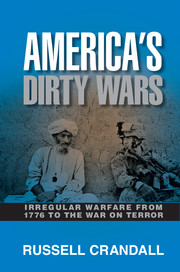Book contents
- Frontmatter
- Dedication
- Contents
- List of Figures
- Acknowledgments
- 1 Introduction
- 2 Irregular Warfare 101
- Part One The American Revolution to Chasing Sandino, 1776–1930s
- 3 The American Revolution
- 4 Confederates and Indians
- 5 Intermezzo
- 6 America, Aguinaldo, and the Philippines, 1898
- 7 Chasing Villa, 1916
- 8 A Cold Winter in Siberia
- 9 The Banana Wars, 1898–1930s
- 10 Intermezzo
- 11 Chasing Sandino, 1927–1932
- Part Two The Cold War, 1940s–1989
- Part Three Latin America and the Cold War, 1950s–1980s
- Part Four Post–Cold War, 1990s–2000s
- Notes
- Bibliography
- Index
11 - Chasing Sandino, 1927–1932
Published online by Cambridge University Press: 05 July 2014
- Frontmatter
- Dedication
- Contents
- List of Figures
- Acknowledgments
- 1 Introduction
- 2 Irregular Warfare 101
- Part One The American Revolution to Chasing Sandino, 1776–1930s
- 3 The American Revolution
- 4 Confederates and Indians
- 5 Intermezzo
- 6 America, Aguinaldo, and the Philippines, 1898
- 7 Chasing Villa, 1916
- 8 A Cold Winter in Siberia
- 9 The Banana Wars, 1898–1930s
- 10 Intermezzo
- 11 Chasing Sandino, 1927–1932
- Part Two The Cold War, 1940s–1989
- Part Three Latin America and the Cold War, 1950s–1980s
- Part Four Post–Cold War, 1990s–2000s
- Notes
- Bibliography
- Index
Summary
All people encountered are unquestionably strong for Sandino. . . . I will have to wage a real blood and thunder campaign and will have casualties every day. I will become involved in a small real war.
– U.S. Marine Corps captain Oliver FloydLike Pancho Villa in northern Mexico, an indefatigable nationalist revolutionary by the name of Augusto César Sandino strung U.S. Marines along a multiyear chase around the Nicaraguan countryside in the latter half of the 1920s. Once again, the mighty United States found itself confounded by a Latin American “bandit.” To make matters worse, Sandino’s charisma and emotive denunciations of American domination of his fellow Nicaraguans made him an international celebrity and turned many against the U.S. campaign in the Central American republic. The hunt came at a time when, following World War I, both the American politicians and the public were wary of the nebulous and protracted dirty wars the United States had been involved in with frequency since its war with Spain in 1898.
The elusive hunt for Sandino is also instructive because it was easily the most important dirty war (the marines themselves called them “small wars”) that the American military fought post-Philippines and pre–World War II. Many military historians attribute the fighting prowess of the U.S. Marines on South Pacific islands such as Iwo Jima to the hard-won lessons they learned over the course of years in the mountains and jungles of Nicaragua.
- Type
- Chapter
- Information
- America's Dirty WarsIrregular Warfare from 1776 to the War on Terror, pp. 136 - 150Publisher: Cambridge University PressPrint publication year: 2014



